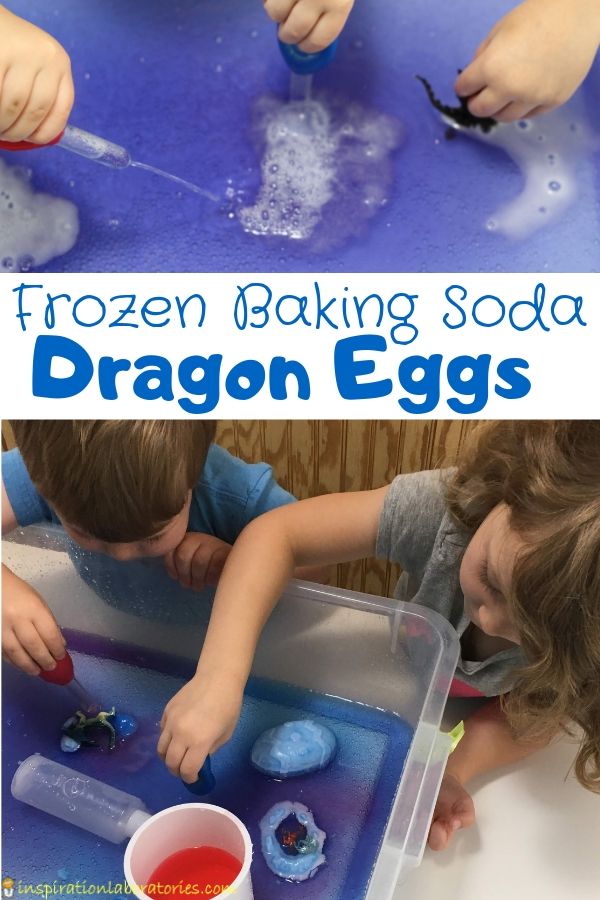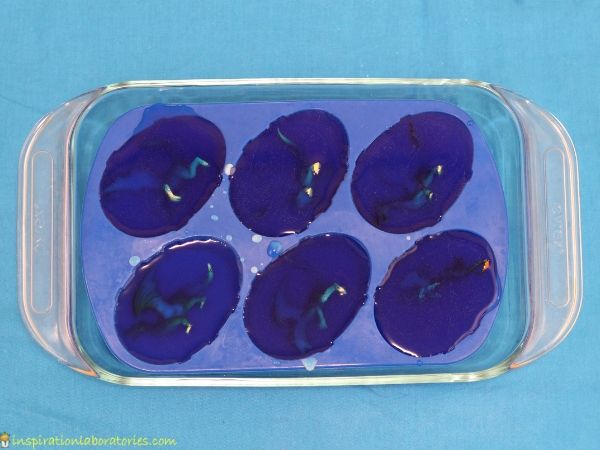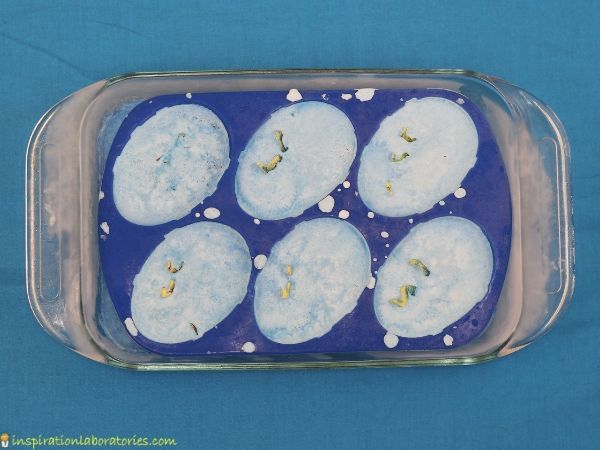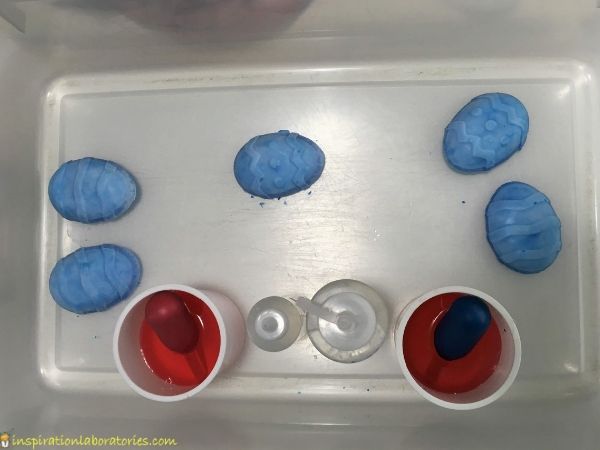Frozen Baking Soda Dragon Eggs
Baking soda and vinegar tops the list of my kids’ favorite sensory science idea. It’s their most requested activity. Today we’re adding a fun twist by making frozen baking soda dragon eggs. I get commissions for purchases made through the affiliate links in this post.

Frozen Baking Soda Dragon Eggs
Supplies Needed for this Sensory Science Activity
- Silicone egg mold (or just use an ice cube tray or a freezer safe bowl)
- Small plastic dragon toys (set of 24 or 48 dragons or Safari Ltd dragon toob or Safari Ltd Good Luck Minis dragons)
- Baking dish
- Tray or container to conduct the activity
- Baking soda
- Vinegar
- Squeeze bottles or droppers and a container
- Washable liquid watercolors
How to Make Frozen Baking Soda Dragon Eggs
The setup for this activity is similar to our frozen dragon eggs ice melting science where we froze dragons in ice. This time we’re freezing baking soda and using vinegar to hatch the eggs.
I used a silicone egg mold to make our dragon eggs. The egg mold is pretty flimsy, so be sure to place a plate or baking dish under the mold for support.

Add about a cup of baking soda to 1 1/4 cups of water. You want the baking soda to mostly dissolve. Add washable liquid watercolors if desired.
Place the dragon toys in the silicone egg mold and cover with the baking soda and water mixture. I found a set of 24 or 48 dragons on Amazon for a good price. I gave most of these away to Lily’s preschool class last spring, but we still have a handful of our own. You could also use the dragons from a Safari Ltd dragon toob or the Safari Ltd Good Luck Minis dragons (they are the tiny dragons in photo above.) Michael’s and Hobby Lobby often have the Safari Ltd dragons, so be sure to use a coupon there.

Place the dragon eggs in the freezer. Remove when completely frozen.

Take the frozen dragon eggs out of the mold and place them in a baking dish, or container. For one egg at a time, a small baking dish will do. I set my 3 kids up with a large storage container.

Add squeeze bottles of vinegar. Or use containers of vinegar with droppers. I picked up the squeeze bottles from the dollar store. The droppers are the Jumbo Eyedroppers from Learning Resources. You could also just spoon or pour on the vinegar. Squeezing the bottles and droppers adds some extra fine motor skills practice.
Add washable liquid watercolors to the vinegar for some color mixing fun, too. I used blue for the baking soda, so I chose red for the vinegar. I actually only placed the colored vinegar in the containers. The squeeze bottles have no added color.

The Science Behind It
Baking soda (sodium bicarbonate) is a base and vinegar (acetic acid) is an acid. When combined, they react to form water, a salt (sodium acetate), and carbon dioxide gas. The bubbles produced by the reaction are the carbon dioxide gas escaping the water. Freezing the baking soda slows down the reaction a little.
Click here to see more baking soda and vinegar activities for kids.
Once all of the dragon eggs have been hatched, you’ll have a sensory bin full of baking soda, vinegar, and water. My kids discovered they could continue to get a reaction if they moved the solution around – either by stirring or by using the droppers.

This happens because not all of the baking soda and vinegar has been used up. As the baking soda and vinegar molecules continue to find each other, you’ll continue to see bubbles.
More Dragon Themed Activities for Kids
- Frozen Dragon Eggs Ice Melting Science
- Dragon Math Kindergarten Counting Game
- Dragon Treasure Sensory Bin
- Dragon Sensory Writing Tray
- Unicorn and Dragon Rainbow Sensory Bin
- Favorite Dragon Books for Kids
Subscribe to the Inspiration Laboratories newsletter. Each issue has exclusive hands-on science explorations for children, a recap of our latest activities, and special resources selected just for you!

Leave a Reply